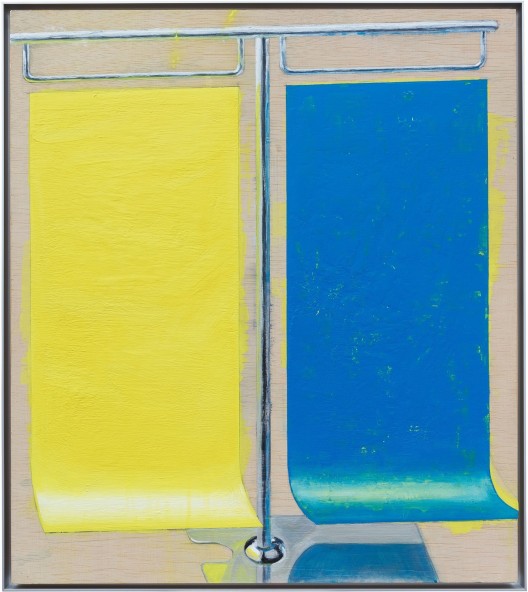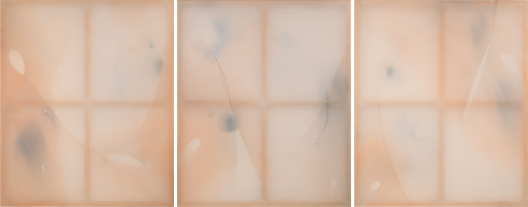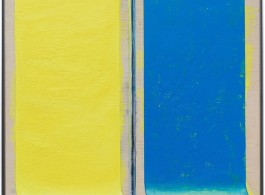‘Etherial Machines’
Mai 36 Galerie and Ota Fine Arts, Shanghai
Mai 36 Galerie and Ota Fine Arts Shanghai are delighted to present Ethereal Machines, a dual exhibition that brings together Chinese artist Zang Kunkun and Singapore artist Guo-Liang Tan.
Strikingly different at first glance, Zang and Tan share more conceptual similarities that are awaiting to be discovered by its viewers, than initially expected. Several works in the exhibition play with the physicality of painting, both as material and as performance, while others put away traditional methods of production and display to consider the sculptural potential of painting.

Zang Kunkun, Barnett Newman in Socialist Society, 2018, Acrylic on wood, 85 x 75 x 4.2 cm
臧坤坤,“巴内特·纽曼在社会主义(社会)”, 2018, 木上丙烯, 85 x 75 x 4.2 cm
Zang Kunkun graduated from the Painting Department of the Tianjin Academy of Fine Art in 2008 but has since moved past the rigid definitions of traditional media into an abstract sphere that challenges the idea of what constitutes painting or sculpture. He playfully reverses work and frame, elongates paintings into an installation, or elevates the meaning of throwaway items by making them the focus of attention.
With a keen eye for detail, Zang incorporates objects from daily life in his native surrounding into his work and by doing so, documents the course of China as a build-up nation. Whether it is a seemingly hastily grouped block of cement, a bag of wooden pegs that used to belong to old tea flasks, a group of seniors loosely gathered around open-air fitness machines – the motifs that have an air of bygone times always go beyond the figurative.
It is on a micro level where Zang meticulously works in a conceptual way that breaks with the ordinary, and results in works that carry different temporal layers, rendering them mature and multi-faceted. His strong relationship to materiality shows in the exceptional use of wood, cement, aluminium, sandpaper, leather and plastic – amongst others - gifting them a new perspective by a young curious individual. However, while his works cannot seem to shake off the hue of collective memory, they also indicate a future of total abstraction, of a void in a vacuum. A faint shadow manifested in acrylic here, a ray of light reflecting in the glimmering copper foil there, Zang’s works subtly make way for hope and transformation.
Trained in Europe and working in Singapore, Guo-Liang Tan operates between different modes of painterly expression, forming new narratives out of painting’s historicity. While his early work uses the conceptual framing of the still-life genre, his more recent paintings look to abstraction as a way to investigate gestures of touch and the transitory nature of mark making.
Tan paints by avoiding direct contact, paint is thinned and allowed to flow, diffuse and spread across a tightly stretched aeronautical fabric. The result is a porous, translucent surface marked by a variety of stains and marks that come across as coincidental but are in fact carefully constructed through a process that resembles a piece of choreography. By applying various bodily gestures — shifting, tilting and turning — he plays fragments against one another without complete resolution, allowing an open work to take shape. This effect is most apparent in the 3 large paintings in this exhibition, titled ‘Peripheral Rituals’. These paintings are like mirrors, reflecting and echoing each other but also deviating through repetition.
Beyond their surface, one also begins to notice the solid stretcher frame in the background. Here, the relationship between surface and support is reversed, collapsing the physical and the abstract into a singular plane that simultaneously attracts and repels its viewer. As in Zang’s work, these paintings are revealed as objects in space, setting the stage to enact and disrupt our idea of painting.
While Zang utilizes industrial materials to provoke our memory of China’s industrial growth and past, Tan’s quiet restraint from grand gestures and statements can perhaps be read in parallel to Singapore’s relatively short and uneven history of painting as well as its transient nature as a place. The gaps and slippages in his paintings implore viewers to raise questions about what they see or do not see, and to experience moments of (un)making.
Ethereal Machines hopes to create an accelerated exchange of ideas on what constitutes painting and how paintings may function as soft engines that shape and shift our perception of history and memory in an expanded material form.

Guo-Liang Tan, “Peripheral Ritual I”, “Peripheral Ritual II”, “Peripheral Ritual III”, 2018, Acrylic on aeronautical fabric and wood, 163 x 408 cm.
陈国良, “外周仪式 I”, “外周仪式II”, “外周仪式 III”, 2018, 木框和航空织物上丙烯, 163 x 408 cm
About the Artists
Despite his tender age, Zang Kunkun (b. 1986, Qingdao) was artistically productive even before his admission to the Tianjin Academy of Fine Arts in 2004. Soon after graduating from the Painting Department, renowned art critics, such as Zhuzhu and, later on, Lu Mingjun (recipient of the CCAA critic award 2017), repeatedly wrote about his works, sharply observing that his style as well as the content of his works strongly differed from a mainstream, a safe(r) direction many new artists first moved towards as a phenomenon posed by a young contemporary art scene in China. With a keen eye for detail regarding his immediate surrounding, Zang’s works are appreciated for the subtle poetry in his otherwise industrial expression that also break with painterly and sculptural traditions. Having mainly shown regionally before, Zang’s selected works from between 2015 and 2017 were included in a successful group show at the Mai 36 Galerie showroom in spring 2017, alongside Spanish artist Jacobo Castellano and Swiss artist Ian Anüll. Following the positive reception, Zang held his very first solo exhibition outside Asia at the gallery in January 2018 that spanned across two floors. His participation in Condo Shanghai 2018 will see his works being exhibited in his native China for the first time again after several years of withdrawing to a private studio that brought about prolific production and further artistic development. Zang Kunkun is represented by Mai 36 Galerie.
Guo-Liang Tan (b. 1980, Singapore) completed his BA in Fine Art & Critical Studies at Goldsmiths College, London and his MFA at Glasgow School of Art. He was also a guest student at The Städelschule, Frankfurt am Main, Germany and an artist-in-residence at the NTU Centre of Contemporary Art. His work has been exhibited and collected in Asia and Europe. A selection of his paintings was selected for the Singapore Platform at the inaugural Art Stage Singapore in 2011. In 2012, he presented his first solo exhibition ‘Play Dead’ at Space Cottonseed. He was subsequently awarded the National Arts Council Scholarship for visual art as well as the Mackendrick Scholarship and the Antje und Jürgen Conzelmann Preis for painting. Most recently, he was also a finalist in the Sovereign Asian Art Prize 2018. Latest exhibitions include ‘The Trouble With Painting Today’ (2014) in Pump House Gallery, London, ‘Peacetime Resistance’ (2015) in Bærum Kunsthall, Oslo and Glasgow Project Room, and ‘Guo-Liang Tan: Ghost Screen’ (2017) in Ota Fine Arts, Singapore. Tan belongs to a generation of artists whose creative output extends beyond his own studio practice. Alongside his own work, he also collaborates with other artists on curatorial and publication projects, including ‘Found & Lost’ (2009) for Osage Gallery and ‘We who saw signs’ (2011) for Institute of Contemporary Arts Singapore. Guo-Liang Tan is represented by Ota Fine Arts.



